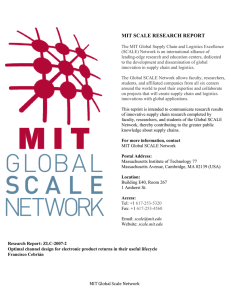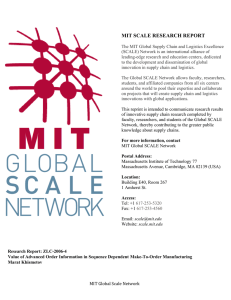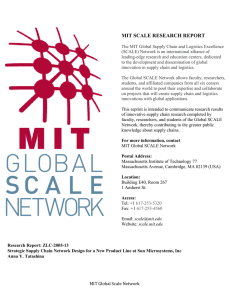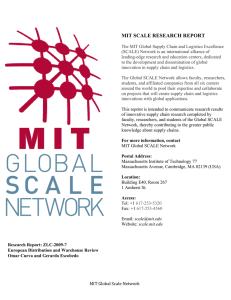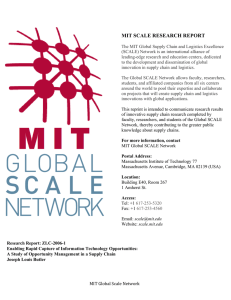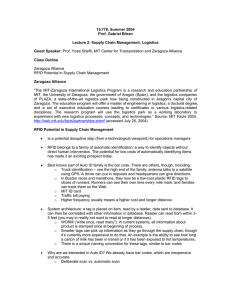MIT SCALE RESEARCH REPORT
advertisement
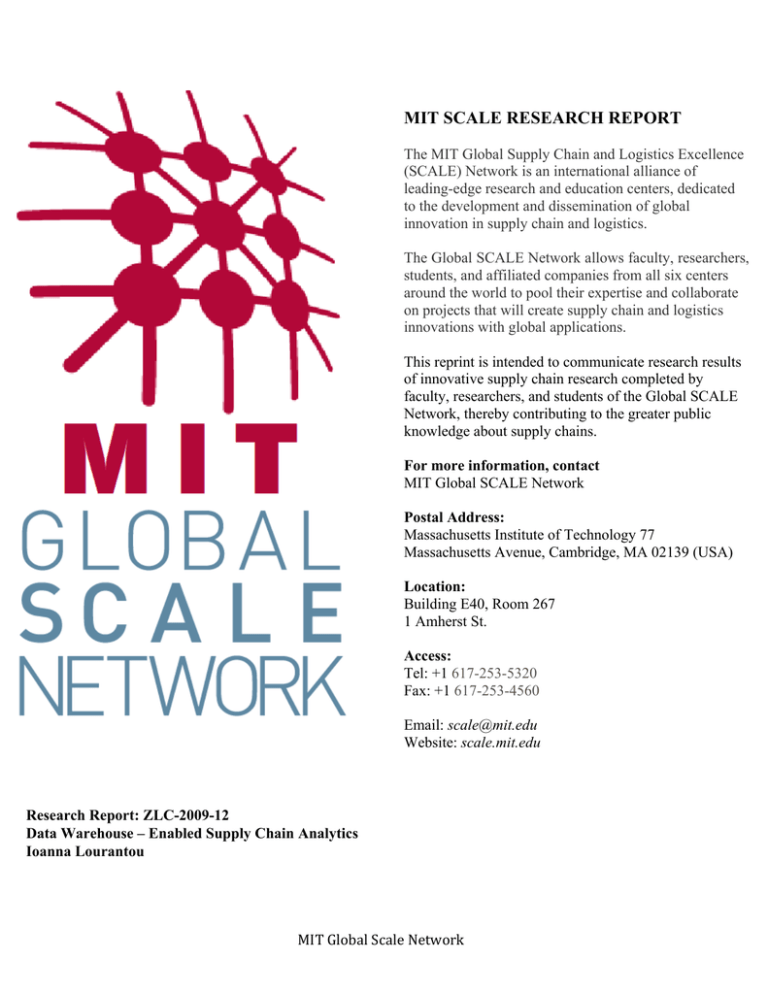
MIT SCALE RESEARCH REPORT The MIT Global Supply Chain and Logistics Excellence (SCALE) Network is an international alliance of leading-edge research and education centers, dedicated to the development and dissemination of global innovation in supply chain and logistics. The Global SCALE Network allows faculty, researchers, students, and affiliated companies from all six centers around the world to pool their expertise and collaborate on projects that will create supply chain and logistics innovations with global applications. This reprint is intended to communicate research results of innovative supply chain research completed by faculty, researchers, and students of the Global SCALE Network, thereby contributing to the greater public knowledge about supply chains. For more information, contact MIT Global SCALE Network Postal Address: Massachusetts Institute of Technology 77 Massachusetts Avenue, Cambridge, MA 02139 (USA) Location: Building E40, Room 267 1 Amherst St. Access: Tel: +1 617-253-5320 Fax: +1 617-253-4560 Email: scale@mit.edu Website: scale.mit.edu Research Report: ZLC-2009-12 Data Warehouse – Enabled Supply Chain Analytics Ioanna Lourantou MITGlobalScaleNetwork For Full Thesis Version Please Contact: Marta Romero ZLOG Director Zaragoza Logistics Center (ZLC) Edificio Náyade 5, C/Bari 55 – PLAZA 50197 Zaragoza, SPAIN Email: mromero@zlc.edu.es Telephone: +34 976 077 605 MITGlobalScaleNetwork Data Warehouse – Enabled Supply Chain Analytics Ioanna Lourantou EXECUTIVE SUMMARY In every business from government to consulting, manufacturing to retailing, logistics to marketing, subsequent to human resources, products and services, the most valuable asset is data. Introduction As the international and local business environment becomes more dynamic and data becomes more profuse, the key question is how businesses and organizations can prepare proactively and use the growing data to make informed decisions. For this reason, enterprises have to know in real time how they are performing, compared to their budgets, to their competitors, and to the results of previous years. In particular, Supply Chain Management executives and analysts need to use transactional data that is generated daily by separate intelligent systems, such as Customer Relationship Management (CRM) Enterprise Resource Planning (ERP) Supplier Relationship Management (SRM) Supply Chain Management (SCM) Warehouse Management System (WMS) Problem Statement In order to provide a reliable “decision making tool” for Supply Chain Management, data from different internal and external sources has to be integrated, homogenized, analyzed and made available in real time. This thesis explores the recent developments in Business Intelligence and Supply Chain Analytics (SCA) and looks for information that is missing in order to create a decision-making tool for enhanced supply chain decisions. The impetus of this research work is based on extensive review of current literature, as well as interviews with executives and field work in companies. Results The results suggest that the data will continue to grow, with financial strains on one hand and demand for fast, flexible decisions on the other, which will determine the competitive edge of the enterprise. SCM and SCA will play a major role in this trend as well as in the financial performance and even in the viability of any operational entity. In order for this to take place, management needs to understand the importance and the potential benefits of data integration. Besides the cost and time needed to implement SCA, there are various examples in the industry, where through data integration, companies and organizations achieved A decrease in inventory holding costs An increase in forecasting accuracy A decrease lead times An improvement customer service level Conclusions and Further Research Finally, through telecommunications, the advantages of interconnectivity and web applications will appear in all Business Intelligence and Supply Chain Analytics applications. To that extent all information, reports, performances, planning decisions and execution will take place “on line – real time (OL-RT), in a global “green economy”, where environmentally-friendly decisions will be made.
